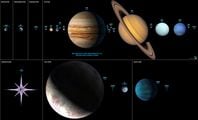Saturn: Difference between revisions
From Halopedia, the Halo wiki
NightHammer (talk | contribs) |
NightHammer (talk | contribs) mNo edit summary |
||
| Line 4: | Line 4: | ||
|name=Saturn | |name=Saturn | ||
|image= | |image= | ||
| | |system=[[Sol system]]<ref name="enc295">'''[[Halo Encyclopedia]]''', ''page 295'' (2011)</ref> | ||
|body=[[Sol]]<ref name="enc295"/> | |||
|position=Sixth planet<ref name="enc295"/> | |||
|moon(s)=62 | |moon(s)=62 | ||
|diameter={{Convert|116464|km|mi}} | |diameter={{Convert|116464|km|mi}} | ||
| Line 16: | Line 18: | ||
|species= | |species= | ||
|population= | |population= | ||
| | |colonized= | ||
|government= | |government= | ||
|hidec=yes | |hidec=yes | ||
}} | }} | ||
Revision as of 02:25, May 18, 2016
| There is more information available on this subject at Saturn on the English Wikipedia. |
| Saturn | |
|---|---|
| Astrographical | |
|
System: |
|
|
Orbiting: |
|
|
Orbital position: |
Sixth planet[1] |
|
Moon(s): |
62 |
| Physical | |
|
Diameter: |
116,464 kilometres (72,367 mi) |
|
Gravity: |
1.139 G |
|
Length of year: |
29.5 Earth-years |
Saturn is a planetary gas giant and the second biggest planet in the Sol system. It is the sixth planet from Sol, after Jupiter.[1]
Saturn is considered one of the more visually appearing objects in the Sol system, due to the gas giant's bright, massive system of planetary rings. Saturn's natural satellites are not as explored as Jupiter's moons.[1] Its practical uses to the UNSC are limited, due to Saturn's distance from Sol and the lack of necessity to be colonized, and therefore it is mostly just a tourist destination.[2] A tourist station called Castellaneta is positioned in geosynchronous orbit on the "sunny side" of Saturn's outermost ring.[3]
Gallery
Saturn as seen in a postcard from Castellaneta
List of appearances
- Halo: New Blood (First appearance)
- Hunt the Truth
Sources
- ^ a b c d e Halo Encyclopedia, page 295 (2011)
- ^ Halo Encyclopedia, page 283
- ^ Halo: New Blood, Chapter 5

